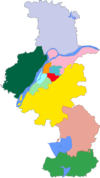Nanjing Yangtze River Bridge
- Machine translation, like DeepL or Google Translate, is a useful starting point for translations, but translators must revise errors as necessary and confirm that the translation is accurate, rather than simply copy-pasting machine-translated text into the English Wikipedia.
- Do not translate text that appears unreliable or low-quality. If possible, verify the text with references provided in the foreign-language article.
- You must provide copyright attribution in the edit summary accompanying your translation by providing an interlanguage link to the source of your translation. A model attribution edit summary is
Content in this edit is translated from the existing Chinese Wikipedia article at [[:zh:南京长江大桥]]; see its history for attribution. - You may also add the template
{{Translated|zh|南京长江大桥}}to the talk page. - For more guidance, see Wikipedia:Translation.
 Beijing–Shanghai railway
Beijing–Shanghai railway Nanjing–Xi'an railway
Nanjing–Xi'an railway Nanjing–Qidong railway
Nanjing–Qidong railway National Highway 104
National Highway 104
China
- People's Government of Nanjing
- Shanghai Railway Bureau
Highway: 4,588 metres (15,052 ft)
Railway: 6,772 metres (22,218 ft)
Railway: 14 metres (46 ft)
- Railway: 30 September 1968
- Highway: 29 December 1968
200 pairs of trains (2011)

The Nanjing Yangtze River Bridge (simplified Chinese: 南京长江大桥; traditional Chinese: 南京長江大橋; pinyin: Nánjīng Chángjiāng Dàqiáo), previously called the First Nanjing Yangtze Bridge, is a double-decked road-rail truss bridge across the Yangtze River in Nanjing, Jiangsu, connecting the city's Pukou and Gulou districts. Its upper deck is part of China National Highway 104, spanning 4,588 metres (15,052 ft). Its lower deck, with a double-track railway, is 6,772 metres (22,218 ft) long, and completes the Beijing–Shanghai railway, which had been divided by the Yangtze for decades. Its right bridge consists of nine piers, with the maximum span of 160 metres (525 ft) and the total length of 1,576 metres (5,171 ft). The bridge carries approximately 80,000 vehicles and 190 trains per day.
The bridge was completed and open for traffic in 1968. It was the third bridge over the Yangtze after the Wuhan Yangtze River Bridge and the Chongqing Baishatuo Yangtze River Bridge. It was the first heavy bridge designed and built using Chinese expertise.
Suicide site
According to state media, the Nanjing Yangtze River Bridge surpassed the Golden Gate Bridge as the most frequent suicide site in the world, with more than 2,000 suicides estimated by 2006.[1][needs update]
Gallery
-
 Vehicles on the Nanjing Yangtze River Bridge
Vehicles on the Nanjing Yangtze River Bridge - Statue of first Yangtze river bridge at Nanjing
- Scenery on the Yangtze river
-
 Nanjing Yangtze River Bridge seen from the upstream right bank
Nanjing Yangtze River Bridge seen from the upstream right bank - Perspective of the double-column frame piers of the railway bridge approach structure
-
 The Nanjing Yangtze Bridge in 2022
The Nanjing Yangtze Bridge in 2022
See also

- Dashengguan Yangtze River Bridge Nanjing's other railway bridge that carries the Beijing–Shanghai High-Speed Railway.
- Yangtze River bridges and tunnels
- List of bridges in China
- Beijing–Shanghai Railway
- Rail transport in China
- Passenger rail transport in China
References
- Notes
- ^ Sun Xiaoyu (September 28, 2006). 2000自杀者为何选择南京长江大桥? [Why have 2,000 people killed themselves at the Nanjing Yangtze River Bridge?]. People's Daily (in Chinese). Archived from the original on February 19, 2015. Retrieved January 12, 2015.
- Bibliography
- Gao Mobo (2008). The Battle for China's Past: Mao and the Cultural Revolution. Pluto Press: Verso. ISBN 978-0-7453-2780-8.
External links
- 纪录片《南京长江大桥》 Nanjing Yangtze River Bridge Documentary (Chinese language) (1969)
- How to get to the Yangtze River Bridge
- Yangtze River Bridge: The Historic Landmark of Modern Nanjing
- v
- t
- e

| Parks and lakes |
|
|---|---|
| Temples |
|
| Historic sites | |
| Other sites |
|
- Nanjing University
- Southeast University
- Nanjing University of Information Science and Technology
- Hohai University
- Nanjing Agricultural University
- China Pharmaceutical University
- Nanjing University of Aeronautics and Astronautics
- Nanjing University of Science & Technology
- Nanjing Normal University
- Nanjing University of Technology
- Nanjing Forestry University
- Nanjing Medical University
- Nanjing University of Finance & Economics
- Nanjing University of Posts and Telecommunications
- Nanjing University of the Arts
- Nanjing Audit University
- Sanjiang College
- Hopkins-Nanjing Center
- Nanjing Library
- Nanjing Railway Station
- Nanjing Metro
- Nanjing Lukou International Airport
- China National Highway 312
- Nanjing Yangtze River Bridge
 Category
Category Commons
Commons






















